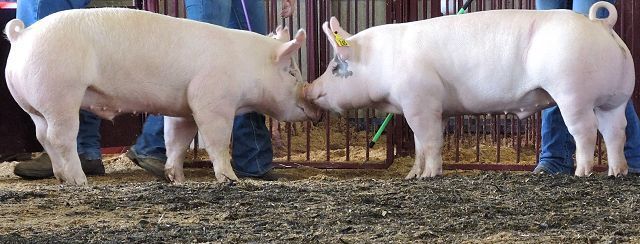Porcine virus not a threat to humans, but will result in higher pork prices
The Porcine Epidemic Diarrhea Virus has killed more than seven million pigs in the United States, a 10 percent reduction in the population in just one year.
The Center for Disease Control says the virus was first reported in the United Kingdom in 1971 and was identified in the Ohio pig population last June. Researchers in the Food Animal Health Research Program at the Ohio Agricultureal Research and Development Center in Wooster are working hard to isolate it and understand how the virus works. The team of Qiuhong Wang, Linda Saif, Tomoichiro Oka and Kwonil Jung are focused on developing diagnostics and a vaccine and then to test the vaccine's effectiveness in pigs.
According to Tony Forshey, chief of animal health for the Ohio Department of Agriculture, “the virus acts like a lawn mower” on the villi in a pig's intestines. These tiny projections in the intestines aid in digestion and without them, the piglets cannot absorb nutrients from food or water. This causes diarrhea and then dehydration in pigs less than three weeks old and results in a mortality rate of close to 100 percent.
Numerous approaches to develop vaccines are underway, but Wang said, “Because PEDV causes high mortality rate in suckling pigs, vaccine development should target pregnant sows. Immunized sows will produce protective antibodies in colostrum and milk to protect suckling pigs from PEDV.”
Saif explained the typical procedure and timeline for developing a vaccine: The virus is grown in cell culture to high virus levels and then either chemically killed so it is not infectious or it is made less deadly by growing it for 80 – 100 passages in cell culture to cripple its ability to produce disease.
For a federally licensed vaccine, Saif said, “this could take two to three years because of stringent regulations in testing the vaccine safety and effectiveness. However for emergency situations, a conditional license might be granted faster for such a vaccine, maybe within one to two years.”
An autogenous vaccine can be developed from the virus strain of the herd of origin, Saif said, but then it can only be used in the same local herd. “These types of vaccines might be available in a year,” he added.
In the meantime, the highly contagious disease has now spread through 30 states, according to the weekly update from the National Animal Health Laboratory Network, and consumers are feeling the effect.
Dave Savage, meat supervisor for Buehler's Fresh Foods, has absolutely seen the effect of PEDV on meat prices. It's simple supply and demand. Since supply is down, he said, “retail prices are up 20 percent over our prior year. The Department of Agriculture is expecting even more of a production loss in 2015.”
This will possibly cause an additional 20 percent increase in pork prices.
Saif and Wang both stressed that to date, a pig is the only host for PEDV, so there is no risk to humans. However, Saif added, “We need to be very vigilant to monitor for new strains of coronavirus like is done routinely to monitor animals and humans for new strains of influenza virus.”

